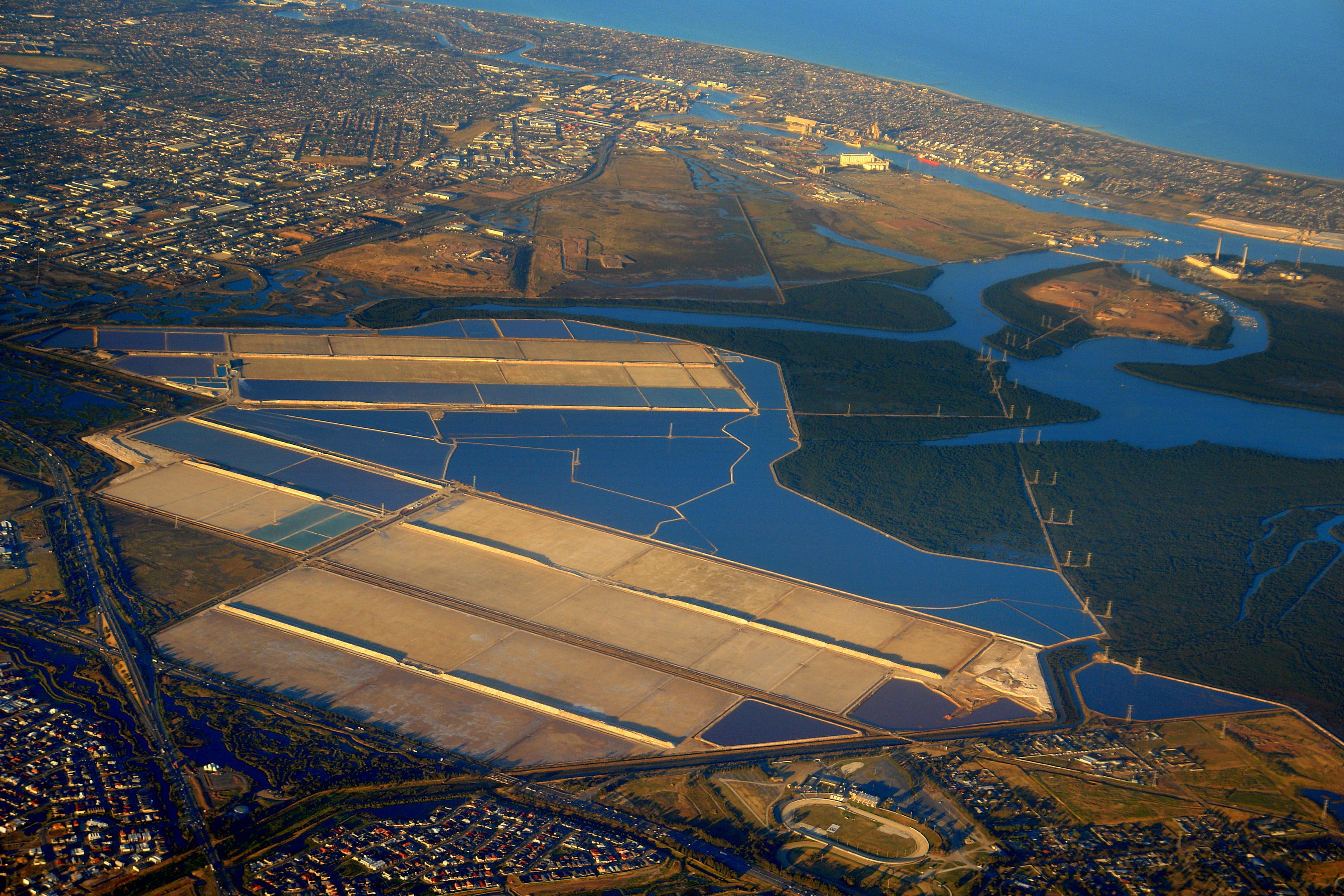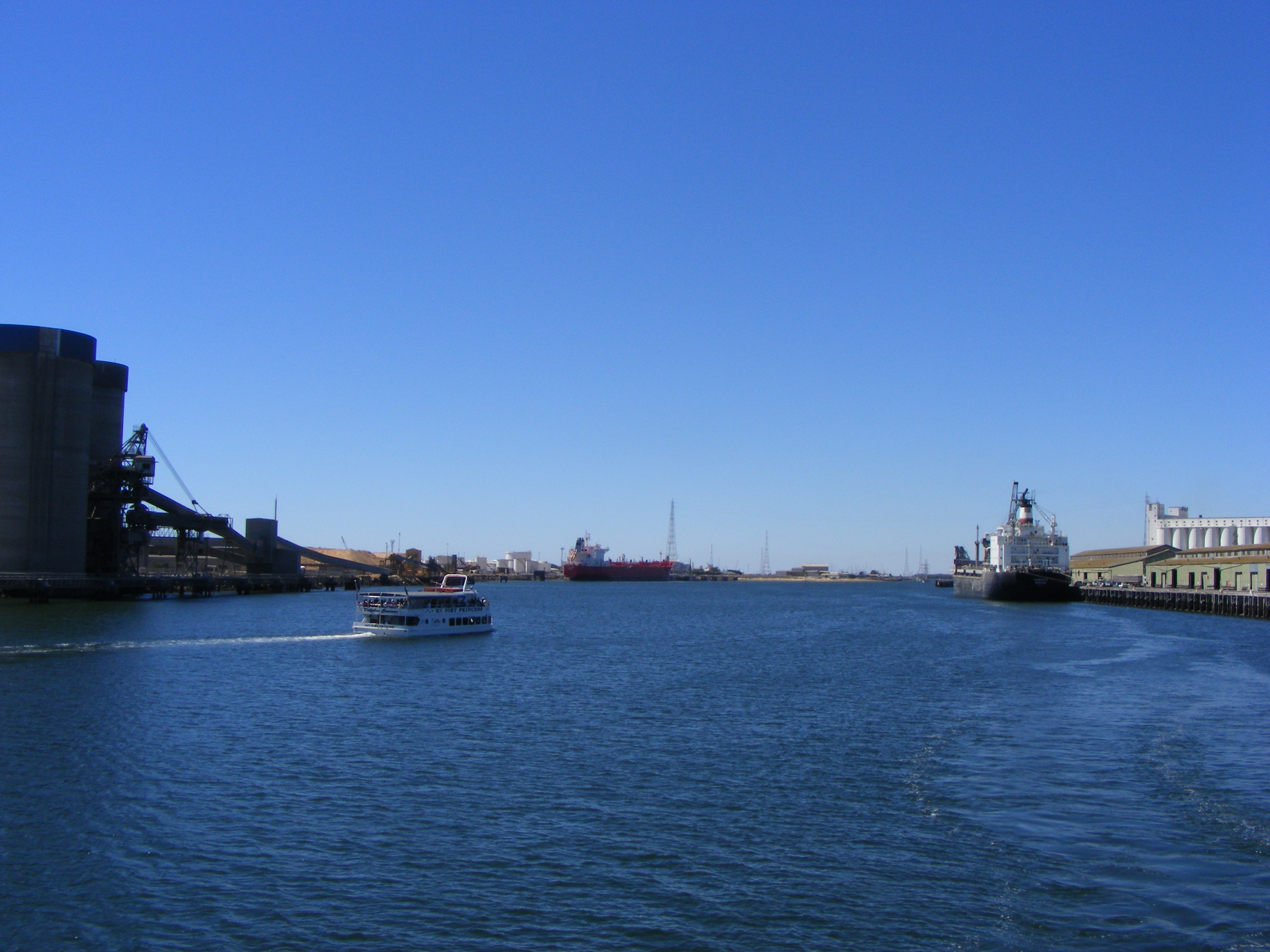|
Jervois Bridge
The Jervois Bridge is a bridge in Greater Adelaide, Australia that crosses the Port River. Construction of the original Jervois Bridge from Port Adelaide to Ethelton commenced in July 1875, using components manufactured in England by Westwood, Baillie. It was the first swing bridge in Australia, with mechanical equipment provided by William Armstrong & Co of Newcastle upon Tyne.Jervois Bridge SA History Hub Built to carry , rail and road traffic, it was officially opened on 7 February 1878 by the |
Port River
The Port River (officially known as the Port Adelaide River) is part of a tidal estuary located north of the Adelaide city centre in the Australian state of South Australia. It has been used as a shipping channel since the beginning of European settlement of South Australia in 1836, when Colonel Light selected the site to use as a port. Before colonisation, the Port River region and the estuary area were known as Yerta Bulti (or Yertabulti) by the Kaurna people, and used extensively as a source of food and plant materials to fashion artefacts used in daily life. The Port River dolphins are a popular tourist attraction. Geography The Port River is the western branch of the largest tidal estuary on the eastern side of Gulf St Vincent. The whole estuarine area, sometimes called the Port River estuary, includes Barker Inlet, Torrens Island, Garden Island, and to a greater or lesser extent touches the suburbs of St Kilda, Bolivar, Dry Creek, Port Adelaide, New Port, and (up ... [...More Info...] [...Related Items...] OR: [Wikipedia] [Google] [Baidu] |
The Observer (Adelaide)
''The Observer'', previously ''The Adelaide Observer'', was a Saturday newspaper published in Adelaide, South Australia from July 1843 to February 1931. Virtually every issue of the newspaper (under both titles) has been digitised and is available online through the National Library of Australia's Trove archive service. History ''The Adelaide Observer'' The first edition of was published on 1 July 1843. The newspaper was founded by John Stephens, its sole proprietor, who in 1845 purchased another local newspaper, the ''South Australian Register''. It was printed by George Dehane at his establishment on Morphett Street adjacent Trinity Church. ''The Observer'' On 7 January 1905, the newspaper was renamed ''The Observer'', whose masthead later proclaimed "The Observer. News of the world, politics, agriculture, mining, literature, sport and society. Established 1843". In February 1931, the ailing Depression-hit newspaper, along with ''The Register ''The Register'' i ... [...More Info...] [...Related Items...] OR: [Wikipedia] [Google] [Baidu] |
Buildings And Structures In Adelaide
A building, or edifice, is an enclosed structure with a roof and walls standing more or less permanently in one place, such as a house or factory (although there's also portable buildings). Buildings come in a variety of sizes, shapes, and functions, and have been adapted throughout history for a wide number of factors, from building materials available, to weather conditions, land prices, ground conditions, specific uses, prestige, and aesthetic reasons. To better understand the term ''building'' compare the list of nonbuilding structures. Buildings serve several societal needs – primarily as shelter from weather, security, living space, privacy, to store belongings, and to comfortably live and work. A building as a shelter represents a physical division of the human habitat (a place of comfort and safety) and the ''outside'' (a place that at times may be harsh and harmful). Ever since the first cave paintings, buildings have also become objects or canvasses of much artistic ... [...More Info...] [...Related Items...] OR: [Wikipedia] [Google] [Baidu] |
Bridges Completed In 1969
A bridge is a structure built to Span (engineering), span a physical obstacle (such as a body of water, valley, road, or rail) without blocking the way underneath. It is constructed for the purpose of providing passage over the obstacle, which is usually something that is otherwise difficult or impossible to cross. There are many different designs of bridges, each serving a particular purpose and applicable to different situations. Designs of bridges vary depending on factors such as the function of the bridge, the nature of the terrain where the bridge is constructed and anchored, and the material used to make it, and the funds available to build it. The earliest bridges were likely made with fallen trees and stepping stones. The Neolithic people built boardwalk bridges across marshland. The Arkadiko Bridge (dating from the 13th century BC, in the Peloponnese) is one of the oldest arch bridges still in existence and use. Etymology The ''Oxford English Dictionary'' traces ... [...More Info...] [...Related Items...] OR: [Wikipedia] [Google] [Baidu] |
Jervois Basin Ships' Graveyard
The Port River (officially known as the Port Adelaide River) is part of a tidal estuary located north of the Adelaide city centre in the Australian state of South Australia. It has been used as a shipping channel since the beginning of European settlement of South Australia in 1836, when Colonel Light selected the site to use as a port. Before colonisation, the Port River region and the estuary area were known as Yerta Bulti (or Yertabulti) by the Kaurna people, and used extensively as a source of food and plant materials to fashion artefacts used in daily life. The Port River dolphins are a popular tourist attraction. Geography The Port River is the western branch of the largest tidal estuary on the eastern side of Gulf St Vincent. The whole estuarine area, sometimes called the Port River estuary, includes Barker Inlet, Torrens Island, Garden Island, and to a greater or lesser extent touches the suburbs of St Kilda, Bolivar, Dry Creek, Port Adelaide, New Port, and (up ... [...More Info...] [...Related Items...] OR: [Wikipedia] [Google] [Baidu] |
Engineers Australia
Engineers Australia (EA) is an Australian professional body and not-for-profit organisation whose purpose is to advance the science and practice of engineering for the benefit of the community. Engineers Australia is Australia's recognized organization for accreditation of professional engineering qualifications under the Washington Accord. As of 2022, EA has 115,000 members, which includes 31,000 students. History The organisation began after World War I, following recognition of the need for a single body to represent engineers, rather than the numerous smaller organisations that existed then. The first council meeting was held in 1919, electing Professor William Warren of the University of Sydney as the first President.Lloyd, B E (1968) ''The Education of Professional Engineers in Australia'', APEA Melbourne.Lloyd, B E (1988) "In Search of Identity: Engineering in Australia 1788–1988", Thesis for Doctor of Philosophy, University of Melbourne On 1 May 1926 the Institutio ... [...More Info...] [...Related Items...] OR: [Wikipedia] [Google] [Baidu] |
Hart's Mill
Hart's Mill is a former flour mill complex located on a bend in the Port River, in the north-western corner of Port Adelaide, South Australia. Now partially restored, it has become the suburb's cultural hub. It has been listed as a state heritage place on the South Australian Heritage Register since 27 May 2004. Its significance is described as follows:Built c. 1889, this substantial mill building is associated with the development of the wheat industry in South Australia in the latter part of the 19th century and specifically with the export of flour from the state through Port Adelaide. It is a rare example of a purpose-built late 19th century flour mill in South Australia, and when considered with the adjacent 1855 Hart's Mill, provides the only known example of two generations of flour mill buildings surviving on one site. The Packing Shed is an uncommon surviving example of an ancillary milling industry building. (HB Assessment Report 12/03) Background After his fina ... [...More Info...] [...Related Items...] OR: [Wikipedia] [Google] [Baidu] |
Fishermen's Wharf Market
Fishermen's Wharf Market, also known as Wharf Shed 1, is a large enclosed building that used to host Sunday markets in Port Adelaide. It is located in the Inner Harbor of Port Adelaide adjacent to the Birkenhead Bridge. History In the 1930s McLaren Wharf was redeveloped to accommodate the increase in volume of shipping coming through Port Adelaide. Market Closure It was open on Sundays from 9am to 4pm. Monday Public Holidays from 9am to 4pm. The Markets where closed in August/September 2022. References External links {{Port Adelaide landmarks, state=collapsed Economy of Adelaide Tourist attractions in Adelaide Retail markets in Australia Retail buildings in South Australia ... [...More Info...] [...Related Items...] OR: [Wikipedia] [Google] [Baidu] |
The News (Adelaide)
''The News'' was an afternoon daily tabloid newspaper in the city of Adelaide, South Australia, that had its origins in 1869, and finally ceased circulation in 1992. Through much of the 20th century, '' The Advertiser'' was Adelaide's morning broadsheet, ''The News'' the afternoon tabloid, with '' The Sunday Mail'' covering weekend sport, and ''Messenger Newspapers'' community news. Its former names were ''The Evening Journal'' (1869–1912) and ''The Journal'' (1912–1923), with the Saturday edition called ''The Saturday Journal'' until 1929. History ''The Evening Journal'' ''The News'' began as ''The Evening Journal'', witVol. I No. Iissued on 2 January 1869. From 11 September 1912Vol. XLVI No. 12,906 it was renamed ''The Journal.'' News Limited was established in 1923 by James Edward Davidson, when he purchased the Broken Hill ''Barrier Miner'' and the Port Pirie ''Recorder''. He then went on to purchase ''The Journal'' and Adelaide's weekly sports-focussed ''Mail'' ... [...More Info...] [...Related Items...] OR: [Wikipedia] [Google] [Baidu] |
Trolleybuses In Adelaide
The Adelaide trolleybus system formed part of the public transport network in Adelaide, South Australia from 1932 until 1963. History During the Great Depression, Adelaide's Municipal Tramways Trust (MTT) needed to expand services, but finances prevented laying new tracks. A decision was made to trial trolleybuses, and a converted petrol bus began running experimentally on the Payneham to Paradise tram line during the off-peak on 18 May 1932. The trial concluded on 11 August 1934, with trams resuming operation. The trial was judged a success and the MTT planned its first permanent trolley bus line. In September 1937, the new service commenced from Light Square in the Adelaide city centre to Tusmore. In 1938, services commenced from Light Square to Port Adelaide, Semaphore and Largs Bay. In October 1952, the Linden Park tram line was converted followed by the Erindale line in May 1953. The trolleybus network closed in July 1963 replaced by motor buses. Fleet Green Goddess ... [...More Info...] [...Related Items...] OR: [Wikipedia] [Google] [Baidu] |
AEC 661T
The AEC 661T was a two-axle double deck trolleybus chassis manufactured by AEC between 1931 and 1942. Based on the AEC Regent bus chassis, 330 were built for United Kingdom operators. References {{AEC range, state=collaped 661 Year 661 ( DCLXI) was a common year starting on Friday (link will display the full calendar) of the Julian calendar. The denomination 661 for this year has been used since the early medieval period, when the Anno Domini calendar era became the ... Trolleybuses Vehicles introduced in 1931 ... [...More Info...] [...Related Items...] OR: [Wikipedia] [Google] [Baidu] |
South Australian Railways
South Australian Railways (SAR) was the statutory corporation through which the Government of South Australia built and operated railways in South Australia from 1854 until March 1978, when its non-urban railways were incorporated into Australian National, and its Adelaide urban lines were transferred to the State Transport Authority. The SAR had three major rail gauges: 1600 mm (5 ft 3 in); 1435 mm (4 ft in); and 1067 mm (3 ft 6 in). History Colonial period The first railway in South Australia was laid in 1854 between Goolwa and Port Elliot to allow for goods to be transferred between paddle steamers on the Murray River and seagoing vessels. The next railway was laid from the harbour at Port Adelaide, to the capital, Adelaide, and was laid with Irish gauge track. This line was opened in 1856. Later on, branch lines in the state's north in the mining towns of Kapunda and Burra were linked through to the Adelaide metrop ... [...More Info...] [...Related Items...] OR: [Wikipedia] [Google] [Baidu] |




.jpg)

